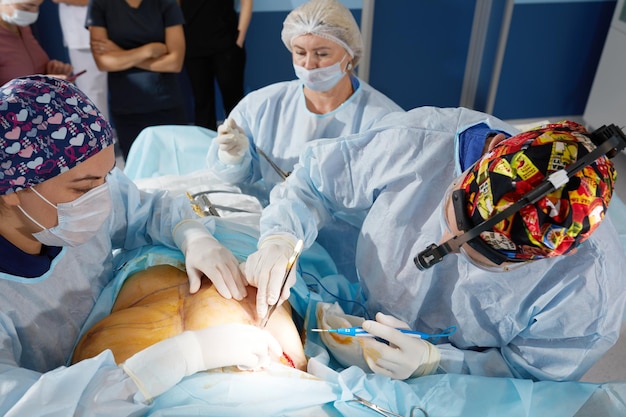
Reduction Mammoplasty
What is mammoplasty? Mammoplasty actually means cosmetic breast surgery, but reduction mammoplasty (breast reduction surgery) is known as mammoplasty. Today, mammoplasty is one of the most popular cosmetic surgeries among women.
How does reduction mammoplasty is done?
Breast reduction surgery is performed on the tissues on your breast by removing excess fat, glandular tissue and skin. In most cases, excess fat may be removed by liposuction instead of the cutting methods described below. If the size of the breast is large due to excess fat tissue and skin, it has no effect because liposuction itself is done for the process of breast reduction. The technique used to reduce breast size can be determined by individual circumstances, the structure of the breasts, how small the breasts are, your personal preferences, and the surgeon’s recommendation.
Step 1 – Anesthesia
Medications are designed for your comfort during breast reduction surgery. These choices include intravenous relief and general anesthesia. Your doctor will suggest the best choice for you.
Step 2 – Tissue Cutting
Tissue cutting include three main steps:
1.Cut a circular pattern around the breasts:
Keep in mind that cutlines remain permanent and visible scratches, although they usually hide well under a swimsuit or bra.
2.Cut a pattern in the shape of a keyhole or in the shape of a rocket around the breast and perpendicular to the nipple:
3.Cut a T-shaped pattern texture in reverse or shield:
Step 3 – Remove the tissue and reshape the breast
After the tissue is made, the nipple changes position. If necessary, the area around the nipple is removed along with the extra skin around it. As the breast tissue reduced, the underlying layer is removed and the breast is formed. Sometimes for big breasts, the nipple and around it may be removed and brought to the upper part.
Step 4 – Close the tissues and suture the incisions
These tissues are joined together to form a smaller breast. Sutures are placed under the breast tissue to make a new breast. The sutures close the sticky skin and the adhesive for skin surgery. The lines on the breast tissue are permanent, but in most cases the scars are fade and can improve dramatically.
Step 5 – View results
The results of breast reduction surgery can be seen immediately. Over time, the swelling will improve after surgery and the tissue scars will disappear. Your recovery will be continued till you reach the satisfaction with your new look.
Risks and complications of mammoplasty surgery:
After surgery, breast reduction can change the sensation of the breast, as well as disrupt breastfeeding. When the incision is large, so that the nipple is grafted, almost all patients lose breast sensation and the ability to breastfeed. If breastfeeding is important to you, it may be best to postpone breast reduction until after breastfeeding ends. Of course, after breast reduction, women say that they have got rid of the symptoms they had due to the large breast. So, in general, the following can be considered as complications of this surgery:
- Decreased ability to breastfeed
- Remaining the scars of incisions as mentioned above
- Asymmetry of the breasts
- The possibility nipple sensation reduction
- Infection and bleeding (there are a possibility of these two complications in any surgery)
Preoperative care for mammoplasty:
Before your mammoplasty, your plastic surgeon will probably check the following:
- Assess medical history and general health. In fact, when medical tests are performed and there is no drug or medical contraindication, then the surgical procedure can be performed.
- Consult about your expectations after mammoplasty surgery
- Check the condition and size of the breasts
- Take photos of your breasts for medical records
- Explain the type of anesthesia used in surgery
- Complete all laboratory tests
- Get a basic mammogram
- Stop smoking before and after surgery
- Avoid aspirin, anti-inflammatory drugs, and herbal supplements to control bleeding during surgery.
- Explain the necessary details to the patient before and after the operation. All incisions are marked and described before surgery. There are different methods for how to perform the surgical procedure, but the choice is made based on the evaluation of conditions, priorities and possibilities. These differences include the methods of incision, the tissue to be removed, and the tissue to be used as the basis for the new breast.
Post-operative care:
The surgery itself takes 3 to 4 hours and the patient is monitored by a medical team. The dressings are removed after a few days and the patient needs home care. There are important examinations performed on postoperative wounds and tissues, as well as blood clots, swelling, and symmetry of the breasts.
The treatment process requires wearing special clothes to support and maintain the breasts in proper conditions and care for them. These conditions and limitation last for about 4 weeks, although one week after the operation you can return to your daily life.
Forcing, bending and lifting should be avoided in the first days after surgery. Because it may aggravate swelling and even bleeding. It is better to use a special bra for a few weeks after the operation to eliminate the swelling. The suture is gradually removed one week to 14 days after the operation with the opinion of the surgeon.
Resume daily activities
Depending on the patient’s occupation, most patients are able to return to work after 2 weeks, but it is generally recommended to take care of breasts seriously for up to 6 months. Finally, it is best to consult with a plastic surgeon about changes in breast size and shape before deciding on breast reduction surgery so that your surgeon can better understand your realistic goals.






